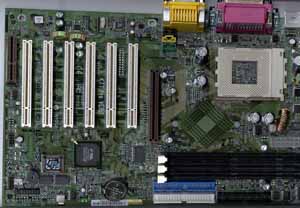Microstar K7T Pro Socket-A KT133 ATX
by Mike Andrawes on July 23, 2000 11:58 PM EST- Posted in
- Motherboards
Microstar really seems to be on a roll lately. First, their BXMaster earned an AnandTech Editor's Choice Gold Award and was the first runner up in our 440BX 133MHz Motherboard Roundup. More recently, they were the first ones that could supply us with a stable Dual VIA 133A board, the 694D Pro.
They've also been one of the biggest supporters of AMD's Athlon, including one of the few board ready at the launch of that processor. They followed that up with the K7 Pro, also based on the AMD 750 chipset, that offerred a number of features over the Fester reference design they used for their original design. Last month AMD released the Socket-A version of the Athlon, codenamed the Thunderbird, as well as the Duron, a budget version of the Thunderbird with less cache. Of course, Microstar was once again there with a motherboard ready at launch. That board is the K7T Pro that we're looking at today.
|
Motherboard Specifications |
|
| CPU Interface |
Socket-A
|
| Chipset |
VIA KT133
|
| Form Factor |
ATX
|
| Bus Speeds |
100
/ 101 / 102 / 103 / 105 / 107
109 / 110 / 111 / 113 / 115 / 117 / 120 |
| Voltages Supported |
Auto Detect
1.70 - 1.85V (in 0.025V increments) |
| Memory Slots |
3 168-pin DIMM Slots
|
| Expansion Slots |
1 AGP Slot
6 PCI Slots (4 Full Length, 1 optional) 1 CNR Slot (Shared) 1 ISA Slot (optional) |
| Onboard Sound |
VIA
VT1611A AC 97 CODEC
|
| BIOS |
AWARD 6.00PGN
|
The Good
One of the first things that jumps out when you look at the K7T Pro is the positioning of the KT133's 8373 North Bridge - it's rotated 45 degrees relative to the edges of the board. While this may not seem like a big deal, it does show that Microstar took the time to make a completely original design rather than just go with the VIA reference design or a slightly modified version of it.
MSI claims that the result of this layout is shorter traces, and thus cleaner signals, to the AGP slot and CPU socket. Combine this with the monstrous 3900uF capacitors that help ensure sufficient power for the CPU and you get a rock solid motherboard - the most stable Socket-A board we've tested to date in fact. Fortunately, those massive capacitors are far enough away that they shouldn't pose a problem for any reasonably sized heatsink, although extremely large ones could have some trouble.
A 6/1/1/0 (PCI/AGP/CNR/ISA) expansion slot configuration is about as good as it gets. The inclusion of a CNR slot is a bit of an odd choice by MSI considering that the VIA 686A "Super" South Bridge does not include integrated network support. Intel's ICH2, available on i815E, i820E, and i840E, is the only chip currently available that includes the hardware necessary to support a network riser card. The CNR slot is shared with the last PCI slot, a trend we're noticing more and more these days. This is much better than the non-shared AMR slots that we saw on the first boards with such a slot and "wasted" PCB space that could potentially be alotted to an additional PCI slot.
Unlike recent Intel chipsets, the VIA 686A Super South Bridge continues to include a PCI-ISA bridge so no additional silicon is required if the optional ISA slot is included. One PCI slot must be given up to make room for that ISA slot if that option is excercised. Like other recent MSI boards with 6 PCI slots, the K7T Pro features a PCI arbiter chip that allows all 6 of those PCI slots to support bus master devices. PCI slots 1 and 6 still share an IRQ, as do slots 3 and 5. Slot 4 shares an IRQ with both onboard USB controllers. For those of you that are still hanging onto one or two older ISA peripherals, the K7T Pro is also available with an ISA slot, but you give up one PCI slot for that legacy support.











0 Comments
View All Comments